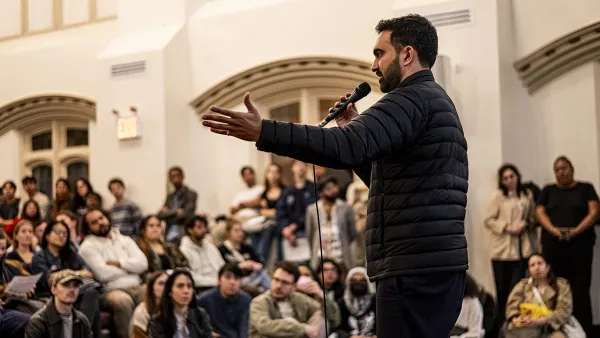Nick Paumgarten imagines a New York City landscape that would result from a present-day economic crisis.
"In the mind's eye, we tend to populate our recessionary streets with squad cars painted green, cat's-eyed ambulances, and other anachronisms-'Fort Apache, the Bronx: The Remake.' But, really, the city will probably just look the way it does now. After an extraordinary era of construction and renovation, demolition and replacement, there will almost certainly come a long period in which little to nothing gets built. Putting aside the long-discussed public projects that are endangered or doomed (the Second Avenue Subway, the West Side Railyards, Brooklyn Bridge Park, Moynihan Station, etc.), dozens of private undertakings have stalled or died. The calls go out to the architects: pencils down. We have inherited, from the good years, a glut of housing, almost all of it of the unaffordable kind-condos galore-and an increase in office space amid a sudden, steep decrease in the need for it. Throw in the high cost, or total unavailability, of capital, owing to the credit freeze, and you have a New York that may be frozen in time. The skyline, which has been very dynamic recently, like a stereo's equalizer display, should sit still for a while. The clothes in our closets today will be the ones we're wearing when we're old."
FULL STORY: The Pits

Planetizen Federal Action Tracker
A weekly monitor of how Trump’s orders and actions are impacting planners and planning in America.

Map: Where Senate Republicans Want to Sell Your Public Lands
For public land advocates, the Senate Republicans’ proposal to sell millions of acres of public land in the West is “the biggest fight of their careers.”

Restaurant Patios Were a Pandemic Win — Why Were They so Hard to Keep?
Social distancing requirements and changes in travel patterns prompted cities to pilot new uses for street and sidewalk space. Then it got complicated.

Platform Pilsner: Vancouver Transit Agency Releases... a Beer?
TransLink will receive a portion of every sale of the four-pack.

Toronto Weighs Cheaper Transit, Parking Hikes for Major Events
Special event rates would take effect during large festivals, sports games and concerts to ‘discourage driving, manage congestion and free up space for transit.”

Berlin to Consider Car-Free Zone Larger Than Manhattan
The area bound by the 22-mile Ringbahn would still allow 12 uses of a private automobile per year per person, and several other exemptions.
Urban Design for Planners 1: Software Tools
This six-course series explores essential urban design concepts using open source software and equips planners with the tools they need to participate fully in the urban design process.
Planning for Universal Design
Learn the tools for implementing Universal Design in planning regulations.
Heyer Gruel & Associates PA
JM Goldson LLC
Custer County Colorado
City of Camden Redevelopment Agency
City of Astoria
Transportation Research & Education Center (TREC) at Portland State University
Camden Redevelopment Agency
City of Claremont
Municipality of Princeton (NJ)




























